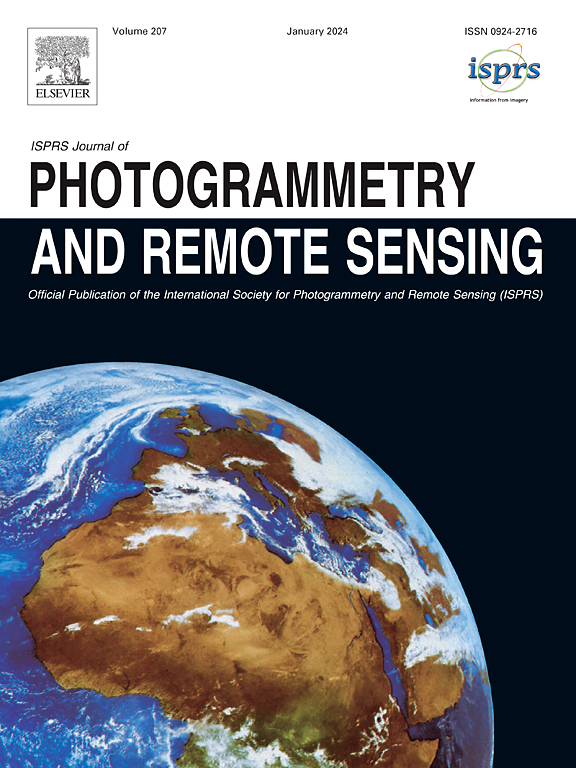深度学习和机器学习可以实现大尺度林地高度、覆盖度和生物量的测绘
IF 10.6
1区 地球科学
Q1 GEOGRAPHY, PHYSICAL
ISPRS Journal of Photogrammetry and Remote Sensing
Pub Date : 2025-05-23
DOI:10.1016/j.isprsjprs.2025.05.016
引用次数: 0
摘要
准确的、空间明确的旱地植被结构量化可以提高我们对这些关键生态系统在地球系统中发挥重要作用的理解。在半干旱林地环境中,由于树高、覆盖度和绿化率低,以及机载激光雷达数据的时空可用性有限,植被结构的遥感具有挑战性。这些限制阻碍了遥感应用在全球广泛分布和具有重要生态意义的旱地系统中的发展。在这项研究中,我们实现了一个U-Net卷积神经网络,能够使用广泛可用的高分辨率航空图像预测piñon-juniper林地的每像素、激光雷达衍生的植被高度。我们利用这些图像和建模的冠层高度数据来构建随机森林模型,以预测树木密度、冠层覆盖和地上生物量。我们的模型在美国西南部广阔的piñon-juniper林地的不同部分的现场数据集上进行了训练和验证,根据方差解释(r2密度= 0.45;R2cover = 0.80;R2biomass = 0.61)和预测误差(%RMSEdensity = 57;%RMSEcover = 19;%RMSEbiomass = 42)。一项比较分析显示,虽然性能略低于仅由机载激光雷达驱动的模型,但它们大大超过了仅由航空图像驱动的模型或由陆地卫星、地形和气候数据组合驱动的模型。尽管结构预测图的特点是航空图像固有的照明和视角差异,但该工作流程代表了在piñon-juniper和其他干旱林地生态系统中进行空间详尽和时间一致的植被结构测绘的可行途径。本文章由计算机程序翻译,如有差异,请以英文原文为准。
Deep learning and machine learning enable broad-scale woodland height, cover, and biomass mapping
Accurate, spatially explicit quantification of vegetation structure in drylands can improve our understanding of the important role that these critical ecosystems play in the Earth system. In semiarid woodland settings, remote sensing of vegetation structure is challenging due to low tree height, cover, and greenness as well as limited spatial and temporal availability of airborne lidar data. These limitations have hindered the development of remote sensing applications in globally widespread and ecologically important dryland systems. In this study, we implement a U-Net convolutional neural network capable of predicting per-pixel, lidar-derived vegetation height in piñon-juniper woodlands using widely available, high-resolution aerial imagery. We used this imagery and modeled canopy height data to construct random forest models for predicting tree density, canopy cover, and live aboveground biomass. Trained and validated on a field dataset that spanned diverse portions of the vast range of piñon-juniper woodlands in the southwestern US, our models demonstrated high performance according to both variance explained (R2density = 0.45; R2cover = 0.80; R2biomass = 0.61) and predictive error (%RMSEdensity = 57; %RMSEcover = 19; %RMSEbiomass = 42). A comparative analysis revealed that, while performance was somewhat lower than models driven solely by airborne lidar, they vastly exceeded that of models driven by aerial imagery alone or a combination of Landsat, topography, and climate data. Although the structural predictive maps featured some artifacts from illumination and perspective differences inherent to aerial imagery, this workflow represents a viable pathway for spatially exhaustive and temporally consistent vegetation structure mapping in piñon-juniper and other dry woodland ecosystems.
求助全文
通过发布文献求助,成功后即可免费获取论文全文。
去求助
来源期刊

ISPRS Journal of Photogrammetry and Remote Sensing
工程技术-成像科学与照相技术
CiteScore
21.00
自引率
6.30%
发文量
273
审稿时长
40 days
期刊介绍:
The ISPRS Journal of Photogrammetry and Remote Sensing (P&RS) serves as the official journal of the International Society for Photogrammetry and Remote Sensing (ISPRS). It acts as a platform for scientists and professionals worldwide who are involved in various disciplines that utilize photogrammetry, remote sensing, spatial information systems, computer vision, and related fields. The journal aims to facilitate communication and dissemination of advancements in these disciplines, while also acting as a comprehensive source of reference and archive.
P&RS endeavors to publish high-quality, peer-reviewed research papers that are preferably original and have not been published before. These papers can cover scientific/research, technological development, or application/practical aspects. Additionally, the journal welcomes papers that are based on presentations from ISPRS meetings, as long as they are considered significant contributions to the aforementioned fields.
In particular, P&RS encourages the submission of papers that are of broad scientific interest, showcase innovative applications (especially in emerging fields), have an interdisciplinary focus, discuss topics that have received limited attention in P&RS or related journals, or explore new directions in scientific or professional realms. It is preferred that theoretical papers include practical applications, while papers focusing on systems and applications should include a theoretical background.
 求助内容:
求助内容: 应助结果提醒方式:
应助结果提醒方式:


